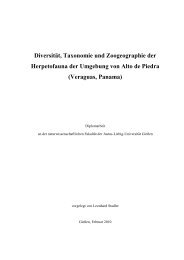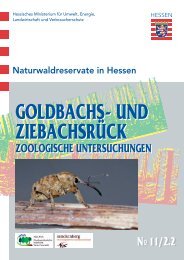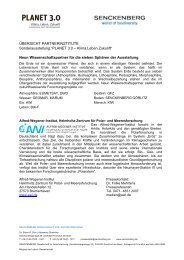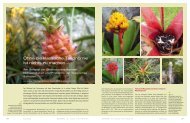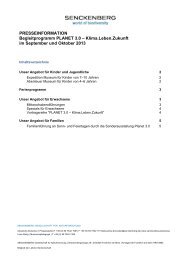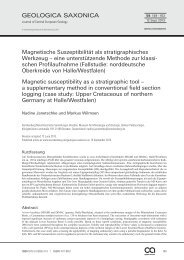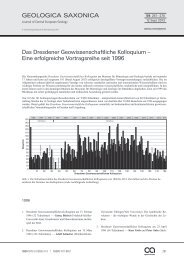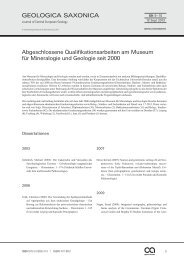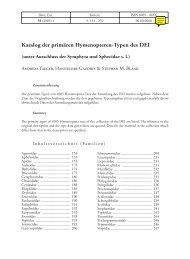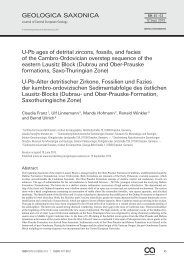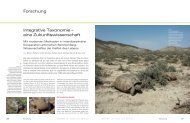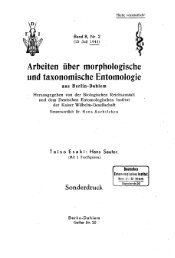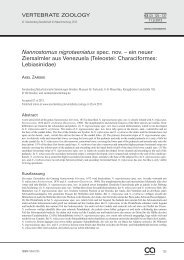Folia Malacologica 9-2.vp - Senckenberg
Folia Malacologica 9-2.vp - Senckenberg
Folia Malacologica 9-2.vp - Senckenberg
You also want an ePaper? Increase the reach of your titles
YUMPU automatically turns print PDFs into web optimized ePapers that Google loves.
INTRODUCTION<br />
MORPHOLOGICAL VARIATION<br />
IN TERRESTRIAL SLUG DEROCERAS TURCICUM<br />
(SIMROTH, 1894) AND A NORTHERN EXTENSION<br />
OF ITS RANGE IN CENTRAL EUROPE<br />
HEIKE REISE 1 ,JOHN M. C. HUTCHINSON 2<br />
1<br />
Staatliches Museum für Naturkunde Görlitz, PF 300 154, D–02806 Görlitz, Germany<br />
(e-mail: smng.reise@t-online.de)<br />
2<br />
Max Planck Institute for Human Development, Lentzeallee 94, D–14195 Berlin, Germany<br />
(e-mail: hutch@mpib-berlin.mpg.de)<br />
ABSTRACT: We report seven new localities of the terrestrial slug Deroceras turcicum (Simroth), including the first<br />
occurrences in the Czech Republic and Slovakia. These demonstrate that the distribution of D. turcicum extends<br />
much further north than known previously and it might even be rather common there. We discuss possible reasons<br />
for its belated discovery. D. turcicum might have often been confused not only with the common<br />
D. reticulatum (O.F. Müll.) but also with the syntopical D. rodnae Grossu et Lupu and D. praecox Wiktor. We<br />
describe its variability in size, coloration, genital morphology, and caecum length, and consider characters for its<br />
reliable discrimination from other species. Two colour morphs (white and violet) are described for the first time.<br />
Intriguingly, the coloration of D. turcicum often matches that of congeners found at the same site, which suggests<br />
that colour has some selective value. Since external appearance often gives no reason to suspect that two species<br />
co-occur at a site, dissection of several specimens is advisable.<br />
Deroceras turcicum (Simroth, 1894) is ausually<br />
cream-coloured slug, externally indistinguishable<br />
from many other species in the genus, including the<br />
very common D. reticulatum (O.F. Müller, 1774). The<br />
external similarity is all the more troublesome as D.<br />
turcicum and D. reticulatum are also very similar and<br />
variable in their genital morphology. D. reticulatum is<br />
widespread in Europe, and has been introduced to<br />
many other areas of the world (BARKER 1999); it is<br />
nearly exclusively limited to habitats that have been to<br />
some extent disturbed (WIKTOR 2000). D. turcicum<br />
seems mainly to live in forests, but it can also be found<br />
in synanthropic habitats (WIKTOR 2000).<br />
So far, D. turcicum is known from the Balkan Peninsula<br />
(Bulgaria, Romania, all countries of the area of<br />
former Yugoslavia, Greece, Albania), Turkey, Italy,<br />
Hungary and Austria (LUPU 1972, REISCHÜTZ 1986,<br />
DHORA &WELTER-SCHULTES 1996, WIKTOR 2000 and<br />
Vol. 9(2): 63–71<br />
pers. comm.). REISCHÜTZ (1986) mentioned that<br />
D. turcicum reaches the most north-western margin<br />
of its area in Austria. However, WIKTOR (1996) suggested<br />
that the species might be more widespread<br />
but had not been recognised owing to its similarity<br />
with D. reticulatum and to the high variability of both<br />
species.<br />
Here we report anumber of new localities for D.<br />
turcicum which throw afresh light on its distribution.<br />
We discuss whether and why it might have been overlooked<br />
until now, make some novel observations on<br />
its external appearance, and examine which anatomical<br />
characters are distinctive.<br />
Two further species will be considered in this context:<br />
D. praecox Wiktor, 1966, and D. rodnae Grossu et<br />
Lupu, 1965, are species of deciduous and mixed forests<br />
in mountains and their foothills. They are closely<br />
related to one another and distinguished from D.
64 Heike Reise, John M. C. Hutchinson<br />
turcicum and D. reticulatum by a flat stimulator and a<br />
rudimentary caecum. D. rodnae occurs from the eastern<br />
Carpathians to SE France and in Spain (WIKTOR<br />
2000). The range of D. praecox is much smaller, in the<br />
METHODS<br />
Most slugs were found during acollecting trip in<br />
spring 1999. However, a few localities were visited at<br />
a different time or more than once. Success was very<br />
poor during the daytime when it was dry, so most of<br />
our collecting was early in the morning. Slugs were<br />
killed either in about 50% ethanol, or by freezing<br />
(in an ultrafreezer at –80°C or in a Dewar flask containing<br />
liquid nitrogen), and then stored in 70%<br />
ethanol. Some slugs collected as juveniles were<br />
raised to adulthood in a constant temperature<br />
chamber at 15°C. Body lengths depend on whether<br />
measured on living slugs fully stretched when crawling,<br />
or on slugs killed in ethanol, or killed by ultrafreezing.<br />
We indicate these different types of measurement<br />
by the suffix L, E or F respectively. An experiment<br />
with D. reticulatum indicated a relation between<br />
the different measurements of roughly<br />
E = 0.6 L and F = 0.5 to 0.7 L. All specimens are in<br />
the collection of the State Museum of Natural History<br />
Görlitz.<br />
We dissected the animals in a standard way, by cutting<br />
the skin just along the left foot fringe and then<br />
peeling the dorsal skin over to the right side. All<br />
drawings were made initially using a camera lucida.<br />
RESULTS<br />
LOCALITIES AND EXTERNAL CHARACTERISTICS<br />
Figure 2 shows the collecting sites listed in the following<br />
sections.<br />
Czech Republic<br />
1) Sudeten Mountains, western Hrubý Jeseník, 16 km<br />
SW of Jeseník, ca. 17°01’E, 50°08’N. Beech forest,<br />
road margin 200 to 800 m S of Branná. Altitude<br />
ca. 550 m.<br />
Collection: 16th May 1999, 45 fully grown slugs. 20<br />
slugs dissected: 18 were D. turcicum and 2 D.<br />
praecox. The latter tended to be slightly larger, and<br />
more intensely dotted, but externally did not differ<br />
considerably.<br />
Size: D. turcicum: 23Lmm (22F mm), 35L mm; 16 slugs<br />
17–29F mm; D. praecox: 29Fmm, 30F mm.<br />
Coloration: both species light cream with greyish<br />
spotting ranging from very little to more intense.<br />
western Carpathian and Sudeten Mountains, embedded<br />
within that of D. rodnae but overlapping little or<br />
not at all.<br />
In all figures the orientation is with the slug’s head<br />
pointing away from the observer (Fig. 1).<br />
Fig. 1. Dissection method<br />
Fig. 2. Collecting sites; for numbers see text<br />
2) Sudeten Mountains, Orlické Hory, Rýzmburk at<br />
stream Úpa, 12 km NE of Jaromìø, ca. 16°03’E,<br />
50°26’N. Forest along stream (mainly beech, hornbeam,<br />
oak, a few conifers). Altitude ca. 310 m.
Collection: 15th May 1999, 19 fully grown slugs and 1<br />
smaller slug. All 15 slugs dissected were adult D.<br />
turcicum.<br />
Size: 14 slugs 18–24F mm, 1 slug 16F mm.<br />
Coloration: the small slug was light cream with very<br />
few, scarcely visible spots; all others were white<br />
without spotting (Fig. 3c).<br />
We also examined a sample of 8 specimens collected<br />
by BRABENEC at the same locality on 29th April<br />
1968 and labelled as D. praecox (mentioned in HUDEC<br />
1970; specimens are in the National Museum of Natural<br />
History Prague, Brabenec collection, number P6p<br />
166/1974). Two of the slugs had been dissected, and<br />
were indeed adult D. praecox. However, we dissected 4<br />
further slugs, of which 3 were adult D. turcicum and 1<br />
an adult D. praecox. Externally, the species were indistinguishable.<br />
All slugs were snowy white, and had no<br />
spots. The internal organs were unpigmented (even<br />
the penes, as in our specimens), and (in contrast with<br />
ours) the gonad and digestive gland were only slightly<br />
creamish. This gave the impression that the slugs were<br />
albinos. The sizes of D. praecox were 20–32 mm, and of<br />
D. turcicum 27–28 mm (all slugs extended).<br />
3) Sudeten Mountains, Oderské Vrchy, 15 km NE of<br />
Olomouc, Hrubá Voda.<br />
We collected at two sites:<br />
3a) Mountains NW of the village, 17°26’E, 49°52.2’N.<br />
Dense forest (ash, beech, hornbeam) and high undergrowth<br />
(mainly Lunaria rediviva) due to earlier<br />
logging. Altitude ca. 530 m.<br />
Collection: 17th May 1999, 21 slugs (4 very small but<br />
at least one of these was sexually mature; 17 fully<br />
grown and appearing senescent). 11th June 1999,<br />
only 4 more slugs found (looking unhealthy; 3 sexually<br />
mature, 1 juvenile). 22 slugs dissected, all D.<br />
turcicum.<br />
Size: 1 juvenile 11F mm, 17 adults 17–26F mm; 3 slugs<br />
put into ethanol after they had died (including<br />
two violet slugs): 15–25 mm.<br />
Coloration: 3 of the animals from the first date had a<br />
striking greyish violet colour (Fig. 3a, b); all others<br />
were cream to brownish cream (Fig. 3a). All were<br />
rather intensely greyish spotted.<br />
3b) Northern margin of the village, beech wood<br />
above stream, ca. 17°26.5’E, 49°51.1’N. In litter<br />
and on ground vegetation. Altitude ca. 400 m.<br />
Collection: 17th May 1999, 15 D. turcicum. 11th June<br />
1999, 2 D. turcicum and 1 D. praecox.<br />
Size: D. turcicum: 2 juveniles 14F mm, 12E mm, 16<br />
adults (including violet slug) 17–24F mm, 3 adults<br />
18–20E mm; D. praecox: 28Fmm. Coloration: D. turcicum: 1 slug violet, the rest cream,<br />
all with intense greyish spotting. D. praecox: cream<br />
with intense grey spotting (like most D. turcicum).<br />
Morphological variation in Deroceras turcicum 65<br />
Fig. 3. Colour morphs of D. turcicum (a and b from Locality<br />
3a, c from Locality 2): a – 3 cream and 1 violet individuals;<br />
b – violet individual (different from that in a);<br />
c – white individual<br />
The slugs from Locality 3 seem to be slightly different<br />
from the other D. turcicum considered in this paper:<br />
they are comparatively small, have a violet colour<br />
morph, and are also more difficult to keep and breed<br />
in the laboratory. We are currently carrying out breeding<br />
experiments to study the genetics of the colour<br />
polymorphism.<br />
4) Èeskomoravská vrchovina, Drahanská vrchovina,<br />
ca. 11 km NE of Brno, between Hostìnice and<br />
Ochoz, above Hádek, 16°45’E, 49°16’N. Beech<br />
wood with single spruce trees along road. Altitude<br />
ca. 400 m.<br />
Collection: 21st May 1999, about 40 slugs, most fully<br />
grown. 13 specimens dissected: 12 adult D.<br />
turcicum, 1 juvenile (species identity unknown).<br />
Size: 7 slugs 20–26F mm, 4 slugs 21–23E mm; 2 slugs<br />
reared till mid-June: 1 juvenile 15F mm, 1 adult 16F mm.<br />
Coloration: light cream to brownish cream, usually<br />
with brownish-grey spotting.
66 Heike Reise, John M. C. Hutchinson<br />
Slovakia<br />
5) Tribeè Mountains, S of Partizánske. We collected at<br />
several localities in the area between Partizánske,<br />
Vel’ký Klíz and Kolaèno, 18°20’–18°24’E,<br />
48°34.5’–48°37’N. Mostly rather dry wood with<br />
oak, hornbeam and the grass Melica, and locally<br />
beech. Altitudes ca. 200–500 m.<br />
Collection: 7th May 1993, 7 adult and 1 juvenile D.<br />
turcicum. 20th May 1999, 1 D. praecox (at a disturbed<br />
site with garden waste).<br />
Size: D. turcicum: 1 juvenile 15F mm (species identity<br />
uncertain); 7 adults 16–23E mm (2 of these 37L mm, 47L mm). D. praecox: 1 adult 27E mm.<br />
Coloration: D. turcicum: brownish cream, intensely<br />
spotted; D. praecox: brownish cream, very intensely<br />
greyish spotted (more than in the D. turcicum, similar<br />
to typical D. reticulatum).<br />
We also collected at another locality, about 11 km<br />
north-east of Partizánske, 18°29.5’E, 48°40.5’N. On<br />
the two occasions only D. praecox was found.<br />
Collection: 8th May 1993, 1 adult. 20th May 1999, 4<br />
adults, 1 very small juvenile (probably just<br />
hatched).<br />
Size: 5 adults 27F , 29F , 20F = 30L , ca . 11E = 26L ,<br />
19E =40Lmm; 1 juvenile 3L mm (later raised until<br />
August).<br />
Coloration: cream, sparsely to very intensely greyish<br />
spotted.<br />
Austria<br />
6) Lower Austria(Niederösterreich), Waldviertel,<br />
Steinegg, 48°37.5’N, 15°34’E. Beech forest near<br />
river Kamp. Altitude ca. 400 m.<br />
Collection: 20th August 1997, several young slugs collected,<br />
but only two survived until adulthood: 1 D.<br />
turcicum and 1 D. rodnae.<br />
Size: D. turcicum: 18Emm (killed November 1999,<br />
adult); D. rodnae: ca.25Fmm (killed December<br />
1999, adult).<br />
Coloration: both species cream, strongly greyish spotted.<br />
Hungary<br />
7) Bükk Mountains.<br />
7a) Bükki Nemzeti Park, near Lillafüred (W of<br />
Miscolc). Beech forest beside road along Lake<br />
Hámori, 48°07’N, 20°35’E. Altitude ca. 350 m.<br />
Collection: 23rd January 1998, 4 D. turcicum (probably<br />
all adult or subadult).<br />
Size: 1 adult 21E mm, others killed 16th April 1999<br />
(27E ,21F ,25Fmm, adults).<br />
Coloration: cream to brownish cream, strongly greyish<br />
spotted.<br />
7b) ca. 1.2 km east of Varbó (church), underneath<br />
hill Csörgo teto, 48°08’N, 20°38’E. Beech forest<br />
beside road between Miskolc and Varbó. Altitude<br />
250 m.<br />
Collection: 23rd January 1998, 1 D. turcicum, kept<br />
alive till 16th April 1998.<br />
Coloration: brownish cream, strongly spotted.<br />
SIGNIFICANCE OF EXTERNAL CHARACTERS<br />
Evidently D. turcicum is very variable in its external<br />
features (Fig. 3). Like D. praecox and D. rodnae, its coloration<br />
can be completely white and unspotted, as<br />
well as light or brownish cream with different<br />
amounts of dark spotting. It can even be violet like<br />
some D. rodnae (REISE 1997, WIKTOR 2000). This<br />
means that D. rodnae is not unique in having a violet<br />
colour morph (WÜTHRICH 1994, JORDAENS et al.<br />
1998, REISE et al., in prep.). Neither the violet nor the<br />
white unspotted morphs have been reported previously<br />
in D. turcicum.<br />
It is interesting that at sites where D. turcicum cooccurred<br />
with D. rodnae or D. praecox, the two species<br />
always had similar coloration and spotting. If we rule<br />
out introgression, this suggests aselective value of the<br />
coloration. Just after dawn and in wet weather active<br />
slugs can be found in some abundance, and the pale<br />
morphs in particular stand out strongly against a dark<br />
unvegetated woodland floor. So one intriguing possibility<br />
is that the resemblance is due to mimicry of<br />
warning coloration.<br />
D. turcicum has been considered as a comparatively<br />
small species of ca. 20–25 mm (in ethanol; REISCHÜTZ<br />
1986, WIKTOR 2000). However, we found aconsiderable<br />
overlap with the other three species, not only because<br />
these species can be as small, but also because<br />
some D. turcicum can reach a larger size.<br />
COMPARISON OF ANATOMICAL CHARACTERS<br />
Most D. turcicum (Fig. 4a-c) have a bipartite penis<br />
with a bulbous distal part and a narrower proximal<br />
part. The distal end of the proximal part has a slight<br />
depression in the middle where the vas deferens enters<br />
the penis. The vas deferens runs along the penis surface<br />
and is visible when dissected in the way shown in<br />
Fig. 1. The retractor inserts at the back side some distance<br />
away from the insertion of the vas deferens. Attached<br />
to a bulge above the insertion of the vas<br />
deferens are the penial glands. These usually branch<br />
from a common trunk and are short or medium long.<br />
The wall of the distal part of the penis facing the body<br />
wall is thick and soft. Inside this is the stimulator, which<br />
typically is rather short and fleshy but more or less flattened,<br />
has a wide base, and is prolonged to a tip on the<br />
left side as viewed in the figure (Fig. 5a-f, i, j).<br />
However, D. turcicum is extremely variable with respect<br />
to its distinguishing anatomical characters.<br />
Table 1 summarises the variation within and between<br />
localities. The penis can be a single sac-like bag
Morphological variation in Deroceras turcicum 67<br />
Fig. 4. D. turcicum, diversity of distal genitalia. Origins of slugs: c, i – Locality 2; e – Locality 3a; b, j – Locality 4; d, g, h, l – Locality<br />
5; f – Locality 6; k – Locality 7; a – Macedonia, near Lake Ohrid, locus typicus; Collectors: c – Brabenec, 1968;<br />
a – Wiktor, 1983; all others – authors, 1993–1999 (see text). bc – bursa copulatrix, dp – distal part of penis, ov – oviduct,<br />
pg – penial glands, pp – proximal part of penis, pr – penis retractor, vd – vas deferens. The dotted line in l indicates the<br />
position of the stimulator. Scale bar =1mm
68 Heike Reise, John M. C. Hutchinson<br />
Fig. 5. D. turcicum, diversity of stimulators: a-k – penes bipartite,<br />
l-n – penes sac-like. Origins of slugs: b – Locality 1; e –<br />
Locality 2; a, k – Locality 3a; d, f, g, m – Locality 4; h, i, l, n<br />
– Locality 5; c, j – Locality 7. Scale bar =1mm<br />
(Fig. 4j-l), or, rarely, seemingly intermediate between<br />
this and the usual bipartite form (Fig. 4g, h). Undivided<br />
penes may be typical for juvenile individuals<br />
(WIKTOR, pers. comm.). However, slugs listed as having<br />
sac-like penes in Table 1 were fully grown and sex-<br />
Fig. 6. D. turcicum, diversity of rectal caecum lengths. Origins<br />
of slugs: a– Locality 2; f, b – Locality 4; c, e, g – Locality 5;<br />
d – Locality 6. Scale bars =1mm<br />
ually mature. The penial glands (usually 3 or 4) also<br />
show a wide range of forms, from rather short unbranched<br />
fingers giving a hand-like appearance, to<br />
very long, thin, branched or unbranched fingers<br />
(Fig. 4). Probably the most variable structure is the<br />
stimulator (Fig. 5). It can be short or long, flattened<br />
or fleshy and nearly conical, and its end is not always<br />
pointed but can be more or less rounded.<br />
The rectal caecum of D. turcicum is always unambiguously<br />
present and in almost all cases much longer<br />
than wide (Fig. 6). However, its length varies considerably,<br />
and we found no correlation with the site of collection.<br />
The caecum of one specimen from Locality 5<br />
is only a little pocket about as long as wide (Fig. 6g);<br />
we nevertheless determined it as D. turcicum because<br />
its penis is typical of this species.<br />
Fig. 7 shows the anatomical characters of D.<br />
reticulatum, D. rodnae and D. praecox. It is evident that at<br />
least the first two species are extremely similar to some<br />
D. turcicum. D. praecox can usually be recognised by its<br />
coiled penial appendix, although one specimen of D.<br />
turcicum has a small appendix-like bag on the proximal<br />
Table 1. Distribution of penis morphotypes at the localities 1 to 7. 2* = collected by BRABENEC 1968, + = present,–=absent,<br />
± = present but not of the typical form, ()=present, but in minority.<br />
LOCALITY<br />
PENIS SHAPE<br />
1 2 2* 3 4 5 6 7<br />
bipartite + + + + (± +) + +<br />
sac-like<br />
VAS DEFERENS<br />
(+) (+) + +<br />
on upper penis surface<br />
PENIAL GLANDS<br />
+ + + + + + (±) + +<br />
short or medium + (±) + + (+) + + +<br />
long<br />
STIMULATOR<br />
+ + + + +<br />
short (s) or long (l) s s s s (l) s (l) l s l<br />
flattened + + (±) + + (±) + (± –) ± (+) + + ±<br />
pointed end at one side + ± + ± + (–) + (–) + +
end of its penis (Fig. 4i). Both D. praecox and D. rodnae<br />
can usually be distinguished from almost all D. turcicum<br />
by their strongly reduced rectal caecum. The long flattened<br />
and rounded stimulator of D. rodnae probably<br />
cannot be used to separate it reliably from D. turcicum.<br />
Most of our D. turcicum have a more or less flattened<br />
stimulator, which occasionally is rather long or has a<br />
rounded end. The stimulator of one D. turcicum was<br />
both long and rounded (Fig. 4g); such cases will appear<br />
extremely similar to D. rodnae. D. reticulatum is<br />
even more difficult to distinguish from D. turcicum<br />
since both have an obvious rectal caecum and some D.<br />
turcicum have a stimulator which is long and fleshy and<br />
rather conical, as in D. reticulatum.<br />
The most reliable character to distinguish D.<br />
turcicum from the other three species seems to be the<br />
position of the vas deference which WIKTOR (2000) described<br />
as at the “side of penis facing viscera and thus<br />
on the body axis”. This corresponds to the side of the<br />
penis visible to the viewer when the slug is dissected as<br />
described above. The site where the vas deferens joins<br />
the penis is close to the base of the penial glands but<br />
DISCUSSION<br />
Our new findings prove that the range of D.<br />
turcicum reaches much further north than previously<br />
Morphological variation in Deroceras turcicum 69<br />
Fig. 7. Distal genitalia, stimulators and caeca of three species similar to D. turcicum. D. reticulatum: Görlitz (Germany, Saxony),<br />
20th September 2000. D. rodnae: penis and left caecum from Knechtsbachtal (Germany, Saxony, mountain range<br />
Sächsische Schweiz), 18th June 1996; stimulator and right caecum from Køí ový Buk (Czech Republic, Lu ické Hory),<br />
17th May 1994. D. praecox: penis from Rýzmburk (Czech Republic, near Jaromìø), 29th April 1968 collected by BRABENEC;<br />
stimulator and caecum from Babia Góra (Poland), 18th May 1999. Two views of the coiled appendix (ca) of the same<br />
specimen of D. praecox are shown. Scale bars =1mm<br />
rather distant from the insertion of the penis retractor.<br />
However, in a few cases the vas deferens is situated<br />
more laterally (e.g. Fig. 4g). This character should be<br />
used together with the other ones: we never found all<br />
“untypical” patterns (penis shape, position of vas<br />
deferens, stimulator, caecum) together.<br />
A. WIKTOR (pers. comm.) has suggested the position<br />
of the ovotestis as a further character that might<br />
distinguish D. reticulatum from D. turcicum. LUTHER<br />
(1915) proposed this as a character to separate D.<br />
reticulatum from Deroceras agreste (L., 1758). In the 26<br />
specimens from 8 localities that we have checked, the<br />
ovotestis of D. turcicum is smaller and more hidden<br />
than in D. reticulatum. It extends caudally most often<br />
to about a half to two-thirds of the distance from the<br />
base of the rectal caecum to the tail end of the body<br />
cavity, while it extends to the end or nearly the end in<br />
D. reticulatum. This distinction needs to be checked in<br />
further populations of both D. reticulatum and D.<br />
turcicum. It would also be necessary to examine how<br />
the character depends on maturity.<br />
recognised. The species had not been recorded from<br />
the Czech Republic or Slovakia. The number of local-
70 Heike Reise, John M. C. Hutchinson<br />
ities and its abundance at some of these sites suggest<br />
that D. turcicum might even be rather common. It now<br />
seems not unlikely that the species occurs also in Poland<br />
and Germany. Malacologists there should be<br />
aware of this when collecting Deroceras in deciduous or<br />
mixed woods.<br />
The abundance of the species at two localities in<br />
the Czech Republic (localities 1 and 4) makes one<br />
wonder why D. turcicum has not been detected there<br />
much earlier. The same question applies to localities<br />
that have been investigated by malacologists before:<br />
Oderské Vrchy (HUDEC 1967), Tribeè Mountains<br />
(KROUPOVÁ 1982), Kamptal near Steinegg, Waldviertel<br />
(REISCHÜTZ 1984). D. turcicum has been<br />
recorded before from the Bükk Mountains (WIKTOR<br />
&SZIGETHY 1983, BÁBA 1992) but only at two localities<br />
despite this being an area of quite intensive<br />
surveying for molluscs (e.g. BÁBA et al. 1983). We cannot<br />
exclude the possibility that D. turcicum has been<br />
expanding from the Balkans towards Central Europe.<br />
However, BRABENEC collected his sample from<br />
Rýzmburk in 1968, and confusion of D. turcicum with<br />
other species seems a more likely explanation.<br />
WIKTOR (1983, 1996, 2000) has repeatedly stressed<br />
the similarity of D. turcicum to D. reticulatum and the<br />
high chance of misidentification. However, D. turcicum<br />
might more often have been confused with D.<br />
rodnae, owing not only to their similar penis shapes,<br />
but also to their similar habitats. The sample from<br />
Rýzmburk shows that D. turcicum can also be confused<br />
with D. praecox, again because of the similar external<br />
appearance and habitat. Although D. turcicum can occasionally<br />
be found in synanthropic habitats (WIKTOR<br />
2000), it is mainly restricted to woodland. It seems to<br />
be rather flexible with respect to the kind of wood: we<br />
have found it not only in rather dry oak and hornbeam<br />
forests, but more often and in greater abundance<br />
in old damp beech forests. For this reason, we<br />
suggest that Central European D. turcicum probably<br />
more often co-occurs with D. rodnae or D. praecox than<br />
with D. reticulatum.<br />
It is indeed striking how similar the three species are<br />
to D. turcicum. At none of our collecting sites had we any<br />
external indication that we had collected two different<br />
species of Deroceras. Therefore, samples of D. rodnae,<br />
D. praecox, or even D. reticulatum from suitable habitats<br />
should be carefully reanalysed. It is necessary to dissect a<br />
number of specimens, both because it may be only a<br />
proportion of acollection that is D. turcicum, a nd<br />
because D. turcicum’s high variability can make species<br />
determination difficult if based on single specimens.<br />
It cannot be ruled out that some published localities<br />
of D. rodnae in Slovakia and Czech Republic are<br />
due to misidentifications of D. turcicum. This is especially<br />
interesting for sites in Slovakia where sympatric<br />
occurrences of the usually allopatric D. praecox and D.<br />
rodnae have been reported (LISICKÝ 1991). For instance,<br />
sympatry has been claimed in the Tribeè<br />
Mountains around Partizánske (KROUPOVÁ 1982,<br />
pers. comm.). We have collected there twice, and<br />
found only D. turcicum and D. praecox. This mountain<br />
range is dominated by dry warm forests with oak,<br />
hornbeam and pine, which seems to fit the habitats of<br />
D. turcicum much better than those of D. rodnae<br />
(WIKTOR 1983, REISCHÜTZ 1986). Unfortunately,<br />
many samples in the Zoological Institute of Bratislava<br />
collected by KROUPOVÁ (later LUÈIVJANSKÁ) have<br />
dried out after her death, including all more or less<br />
adult specimens from this area labelled as D. rodnae.It<br />
would thus be most valuable to search anew for D.<br />
rodnae from this area, as well as to check samples from<br />
neighbouring areas.<br />
Given the difficulty of distinguishing D. turcicum,<br />
one might wonder whether it represents a real taxonomic<br />
unit. However, apreliminary enzyme study including<br />
specimens from three of the Czech localities,<br />
and the Slovak and the Hungarian localities, has indicated<br />
D. turcicum’s taxonomical integrity, and a close<br />
relationship with D. reticulatum (REISE et al., in prep.).<br />
ACKNOWLEDGEMENTS<br />
We are grateful to V. PFLEGER (National Museum<br />
of Natural History Prague) for the loan of slugs, to J.<br />
ŠTEFFEK for all his efforts to make the collection of V.<br />
Luèivjanská available to us, and to L. PINTÉR for information<br />
on a Hungarian locality. S. ZIEBART, K.<br />
BULMAN and T. SZÉKELY helped us to collect some of<br />
the slugs. Thanks to T. BACKELJAU, B. BAUR, I.<br />
FLASAR, and A. WIKTOR for their comments on the<br />
manuscript. A. WIKTOR (Museum of Natural History<br />
Wroc³aw) deserves our particular thanks also for his<br />
insightful discussion of our ideas, for checking some<br />
of our identifications, and for providing a specimen<br />
of D. turcicum from the type locality.<br />
NOTE ADDED IN PROOF<br />
A paper by S. V. JOVANOVIÆ (1999, Arch. Biol. Sci.,<br />
Belgrade 51(4): 219–233), on D. turcicum from Macedonia,<br />
was discovered too late to be discussed here.<br />
However, the distinguishing characters proposed<br />
there seem not to apply consistently to our specimens.
REFERENCES<br />
BÁBA K. 1992. Terrestrial snail assemblages in the Bükk<br />
Mountains. Abstr. bot. 16: 109–127.<br />
BÁBA K., VARGA A., WAGNER M., ZSENI L. 1983. Daten zu<br />
den die Verbreitung der Landschnecken im Bükk-Gebirge<br />
beeinflussenden biotischen Faktoren. Soosiana<br />
10/11: 25–30.<br />
BARKER G. M. 1999. Naturalised terrestrial Stylommatophora<br />
(Mollusca: Gastropoda). Fauna of New Zealand 38.<br />
Manaaki Whenua Press, Lincoln, Canterbury, N.Z.<br />
DHORA D., WELTER-SCHULTES F. W. 1996. List of species and<br />
atlas of the non-marine molluscs of Albania. Schr. Malakozool.<br />
9: 90–197.<br />
HUDEC V. 1967. Neue Funde der Nacktschnecken Lytopelte<br />
herculana Grossu, 1964 in Bulgarien und Deroceras praecox<br />
Wiktor, 1966 in der Tschechoslowakei (Mollusca). Vìstník<br />
Ès. spol. zool. 31: 349–354.<br />
HUDEC V. 1970. Für die Tschechoslowakei neue Nacktschneckenarten<br />
(Pulmonata, Limacidae, Deroceras). Biológia,<br />
Bratisl. 25: 109–122.<br />
JORDAENS K., BACKELJAU T., REISE H., VAN RIEL P., VERHA-<br />
GEN R. 1998. First record of Deroceras juranum outside the<br />
Jura Mountains (Pulmonata: Agriolimacidae). J. Moll.<br />
Stud. 64: 495–499.<br />
KROUPOVÁ V. 1982. Mäkkýše amoznosti vyuzitiaich výskumov<br />
pri ochrane prírody horného Ponitria. Homa Nitra<br />
10: 129–153.<br />
LISICKÝ M. J. 1991. Mollusca Slovenska. Slovak Academy of<br />
Sciences, Bratislava.<br />
LUPU D. 1972. Étude anatomique comparé de quelques<br />
espèces du genre Deroceras Rafinesque 1820. Trav. Mus.<br />
Hist. nat. “Grigore Antipa” 12: 85–100.<br />
LUTHER A. 1915. Zuchtversuche an Ackerschnecken (Agriolimax<br />
reticulatus Müll. und Agr. agrestis L.). ActaSoc.<br />
FaunaFlorafenn. 40: 1–42.<br />
Morphological variation in Deroceras turcicum 71<br />
REISCHÜTZ P. L. 1984. Beiträge zur Molluskenfauna Niederösterreichs,<br />
VI. Die Molluskenfauna des Kamptales zwischen<br />
Schloß Rosenburg und der Ruine Steinegg (Waldviertel).<br />
Heldia1: 29–32.<br />
REISCHÜTZ P. L. 1986. Die Verbreitung der Nacktschnecken<br />
Österreichs (Arionidae, Milacidae, Limacidae, Agriolimacidae,<br />
Boettgerillidae). Sitzungsber., Österr. Akad.<br />
Wiss., Math.-Naturwiss. Kl., Abt. I 195 Suppl. 2: 67–190.<br />
REISE H. 1997. Deroceras juranum – aMendelian colour morph<br />
of D. rodnae (Gastropoda: Agriolimacidae). J. Zool.<br />
Lond. 241: 103–115.<br />
REISE H., BACKELJAU T., ZIMDARS B., in prep. Systematics<br />
and population genetic structure in a complex of cryptic<br />
terrestrial slugs – an allozyme study (Mollusca: Pulmonata:<br />
Agriolimacidae).<br />
WIKTOR A. 1983. The slugs of Bulgaria (Arionidae, Milacidae,<br />
Limacidae, Agriolimacidae – Gastropoda, Stylommatophora).<br />
Ann. Zool. 37: 71–206.<br />
WIKTOR A. 1996. The slugs of the former Yugoslavia (Gastropoda<br />
terrestria nuda – Arionidae, Milacidae, Limacidae,<br />
Agriolimacidae). Ann. Zool. 46: 1–110.<br />
WIKTOR A. 2000. Agriolimacidae (Gastropoda: Pulmonata)–<br />
a systematic monograph. Ann. Zool. 49: 347–590.<br />
WIKTOR A., SZIGETHY A. S. 1983. The distribution of slugs in<br />
Hungary (Gastropoda: Pulmonata). Soosiana 10/11:<br />
87–111.<br />
WÜTHRICH M. 1994. Deroceras (Plathystimulus) juranum n. sp.,<br />
eine endemische Nacktschnecke aus dem Schweizer<br />
Jura. Arch. Moll. 122: 123–131.<br />
received: March 15th, 2001<br />
accepted: May 20th, 2001



